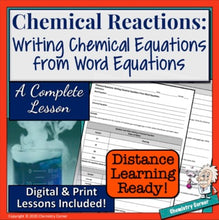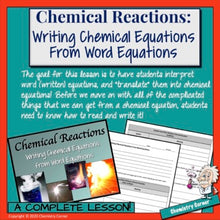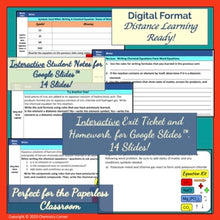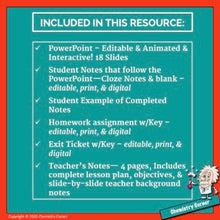Before students get into balancing chemical equations, they need to know exactly what the equation is saying. The goal for this lesson is to have students interpret word (written) equations, and “translate” them into chemical equations! Before we move on with all of the complicated things that we can get from a chemical equation, students need to know how to read and write it!
In this lesson, students will write chemical formula equations from word equations and word problems. They will use states of matter symbols, arrows, and conditions symbols. Students will also be introduced to the seven diatomic elements, and learn how to identify them in a reaction, and properly write them in an equation. They will not be balancing these equations. That comes in the next lesson: Chemical Reactions: Balancing Chemical Equations
***THIS LESSON IS INCLUDED IN TWO DIFFERENT BUNDLES***
Chemical Reactions Lesson Bundle
Chemical Reactions Mega Unit Bundle
Lesson Objectives:
-
Write chemical equations from word equations and word problems.
-
Use common symbols such as states of matter and arrows when writing chemical equations.
-
Name the seven diatomic elements and write them correctly in a chemical equation.
Prior Knowledge:
Students should be very familiar with writing chemical formulas – ionic, molecular, & acids
Teacher Prep Time:
Just print and go!
Lesson Duration:
One class period plus extra practice
Included in This Resource:
PowerPoint Presentation – Editable & Animated – 19 slides
Student Notes – Cloze Notes – editable, print, & digital
Student Notes – Blank
Student Notes Suggested KEY
Exit Ticket –w/ KEY – editable, print, & digital
Homework/Practice w/ KEY – editable, print, & digital
Teacher Notes (3 pages full of some great background info, and much more)
This lesson is appropriate for grades 9-12 chemistry & physical science
Note on the PowerPoints: The PowerPoints included in this product are editable. They are also animated, which means that they may appear busy or overlapping in the slide edit mode, but will be awesome in the slide show mode! Please don’t edit the PowerPoints until you have seen them in the slide show mode!
You will want to save this lesson and use it for years to come!
Chemistry Corner
**************************************************************************************
Check out these other products that you may be interested in:
Chemical Reactions: An Introduction Lesson
Chemical Reactions: Balancing Chemical Equations
Chemical Reactions: Types of Chemical Reactions
The Pit: A Chemistry Trading Game – Types of Reactions Edition
Chemistry Lab – Evidence of a Chemical Reaction
Chemistry Doodle Notes for the Year – A Growing Bundle
High School Chemistry Year Curriculum: A Growing Bundle
*************************************************************************************
Chemistry Corner’s PowerPoints are perfect for the flipped classroom. However, please read the Copyright Terms below before using them as such. Thanks!
LICENSING TERMS: By downloading this product, you own a license for one teacher only for personal use in your classroom. Licenses are non-transferable, meaning they cannot be passed from one teacher to another. No part of this resource is to be shared with colleagues or used by an entire grade level, school, or district without purchasing the proper number of licenses. I you are a coach, principal or district interested in transferable licenses to accommodate yearly staff changes, please contact beth@chemistrycorner.com.
COPYRIGHT TERMS: ©Chemistry Corner. Please note – all material included in this resource belongs to Chemistry Corner. By downloading, you have a license to use the material, but you do not own the material. This resource, or any portion of this resource, may not be uploaded to the internet in any form, including classroom/personal websites or network drives, unless the site is password protected and can only be accessed by students—no other teachers or anyone else on the internet.








